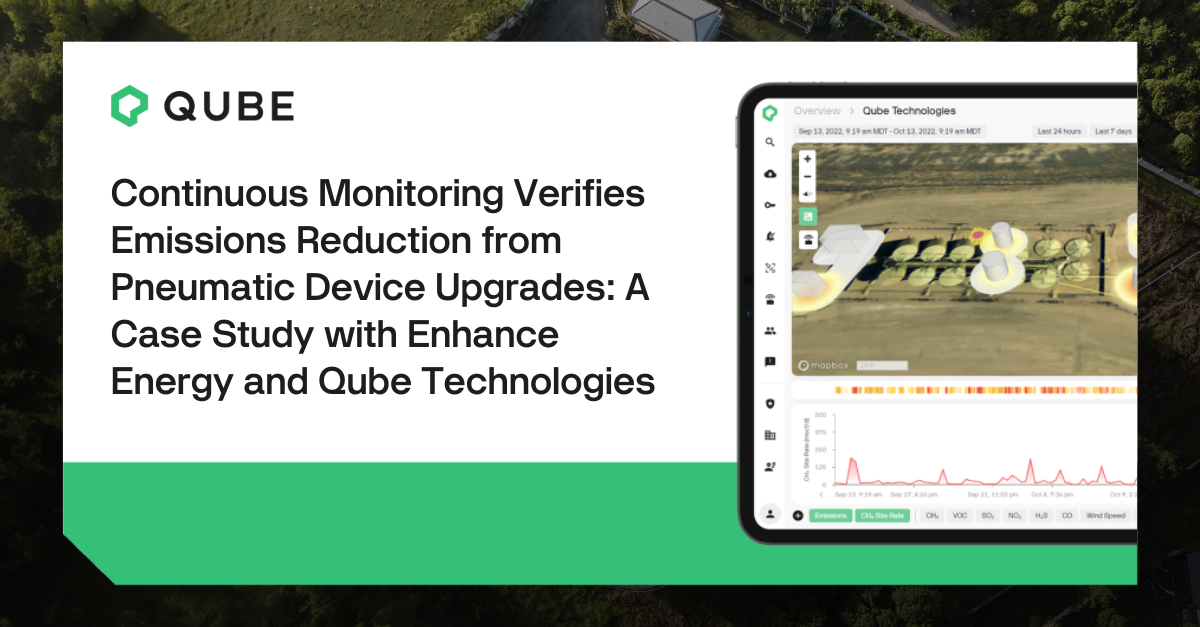
Expert Industry Insights
Get unique insights from Qube Technologies' experts to make better decisions and foster innovation.
How Qube’s Automated Alarms Caught a Cow at the Wellsite
A Colorado operator using Qube’s continuous methane monitoring system received an automated alert about an unexpected emissions spike at a wellhead. Upon investigation, the field team discovered the source: a cow had rubbed against the equipment and opened a manual ball valve, unintentionally releasing gas. The team quickly shut the valve, restored normal readings, and installed fencing to prevent similar incidents. Thanks to Qube’s real-time alerts, the issue was resolved within an hour—without downtime or emissions escalation.
QB Energy and Qube Technologies Resolve Thief Hatch Leak Leading to 97% Emissions Reduction
“Another Win for Continuous Monitoring”
-Air Compliance Manager-QB Energy
Missed by AVO, caught by continuous monitoring. When Qube Technologies flagged elevated methane at a QB Energy tank site, field teams were able to locate and fix a leaking thief hatch—achieving a 97% emissions drop in hours. This case study shows how real-time continuous monitoring data and a fast response can keep operations running smooth.
How Qube Helped One Permian Operator Detect Offsite Emissions
Qube Technologies’ continuous emissions monitoring solutions provide operators with the tools to differentiate offsite from onsite emissions. Furthermore, our data modeling and intuitive dashboard omit those outside emissions from your facility total.
AER Directive 060 Updates: Streamlined Compliance with Qube’s Continuous Monitoring Solution
Explore key updates to Alberta Directive 060 simplifying alt-FEMP adoption and learn how Qube’s continuous monitoring ensures seamless compliance and efficiency.
EPA Deregulation and Methane Monitoring: What Operators Need to Know
The EPA is pushing its most aggressive deregulatory effort yet, aiming to roll back key methane regulations. However, legal and procedural roadblocks could stall or block these changes, leaving operators in regulatory limbo. For now, existing EPA rules—like quarterly LDAR inspections—remain in full force. With legal battles expected to drag on for years, proactive methane monitoring is essential for compliance, asset integrity, and investor confidence. Stay ahead of the uncertainty—here’s what you need to know.
Congress Votes to Repeal EPA’s Waste Emission Charge (WEC) Implementing Rule
Congress has voted to repeal the EPA’s Waste Emissions Charge (WEC) rule, also known as the methane fee, which imposed financial penalties on large methane emitters in the oil and gas sector. While this eliminates the direct fee, EPA methane reporting requirements and state regulations still apply, meaning operators must continue monitoring and reporting emissions.
Methane Rules in Flux - What’s Changing & What Operators Need to Know
With the new Trump administration, methane regulations are in flux - but compliance remains essential. While some rules are being reviewed, others remain in effect, and operators need to stay prepared. Here’s a quick breakdown of what has changed (and what hasn’t) since Trump took office.
Don’t Let Third Parties Call Out Your Super Emitters: Stay Ahead with Qube’s Continuous Monitoring Solutions
Qube Technologies’ continuous emissions monitoring solutions provide operators with the tools to detect and respond to emissions trends before they become super emitter events. By configuring real-time alarms, operators can take corrective action immediately, preventing third-party reports and ensuring regulatory compliance.
Meeting AER Directive 060 Updates with Qube’s Proven alt-FEMP Solutions
Qube’s continuous monitoring (CM) solutions set a new standard for emissions management. On-site sensors detect methane leaks in real time, even in adverse conditions. Advanced analytics quantify leak intensity and calculate emissions, allowing for targeted remediation planning.
U.S. Election 2024: Implications for Methane and Emissions Regulations Under a Republican Trifecta
Qube Technologies remains proactive in supporting EPA compliance, offering continuous monitoring solutions with advanced tracking features. Qube has also applied to have its technology recognized as an alternative for NSPS OOOOb/EG OOOOc standards, positioning clients for seamless adaptation to changing requirements.
Navigating US Methane Regulations: Qube’s Continuous Monitoring Solutions for Proactive Compliance
Evolving regulations demand operator compliance to ensure efficient and cost-effective operations. Qube, a leader in continuous methane monitoring, helps clients across industries, including oil and gas, meet these regulatory challenges.
Pioneering Methane Monitoring: How Qube Technologies’ Unique Controlled Release Test Facility (CRTF) Drives Real-World Precision
Qube Technologies has built the Controlled Release Test Facility (CRTF), roughly 60 km (~ 37 mi) west of Calgary, Alberta, which functions as a specialized field environment to conduct continuous monitoring (CM) emissions tests under controlled real-world conditions.
Interrogating Emissions Using the Qube Platform
Qube’s platform provides continuous emissions monitoring, using wind data, gas concentration, and source identification algorithms to detect methane leaks. However, users must verify alerts, as the algorithm benefits from operational input to ensure accurate source identification.
Continuous Monitoring Verifies Emissions Reduction from Pneumatic Device Upgrades: A Case Study with Enhance Energy and Qube Technologies
By upgrading high-bleed pneumatic devices to low-bleed controllers and implementing robust monitoring programs, operators can achieve significant reductions in methane emissions. These proactive measures are essential for complying with evolving regulations and minimizing environmental impact.
How Qube Technologies’ Methane Sensors Achieve Reliable Accuracy in Long-Term Deployments
This study reinforces a core value proposition of the Qube platform: minimal sensing hardware is required to accurately quantify methane emissions, and the devices remain reliable year after year in the field without manual intervention.
Using Continuous Monitoring to Detect Incomplete Combustion and Reduce Emissions
Qube deployed continuous monitoring devices with CH4 and CO sensors throughout a customer’s natural gas processing facility. The Qube sensors detected elevated emissions – specifically, increased CO concentrations – and reported this data to the customer via Qube’s dashboard.
Understanding Intermittent Emissions and How CM Technology Fills the Gaps
Emissions from oil and gas facilities are dynamic and often intermittent, meaning that standard measurement techniques may only capture a small portion of a facility's actual emissions. This is commonly known as intermittency, referring to the sporadic release of gases caused by operational changes or equipment issues.
How Continuous Monitoring Maximized the Value of Biogas for Roeslein Alternative Energy
This pilot showed that leaks do not occur at consistent intervals or emission rates. In fact, just 5% of the detected leaks represented ~55% of the total emissions over nine months of data collection. This distribution is similar to the oil and gas sector, where research has found that the top 5-10% of leaks represent 60-80% of emissions.
White Paper: Reducing methane emissions: Implementing data science informed operation and maintenance work practices using continuous monitoring technology (abstract)
Continuous monitoring technologies allow operators to implement novel operation and maintenance work practices to efficiently respond to methane emissions
Geothermal power plant emissions detection
One of the largest power producers in Indonesia implemented Qube‘s continuous monitoring solution to monitor for H2S gas at a new geothermal facility.




















